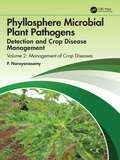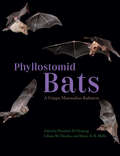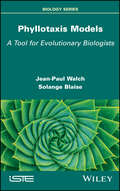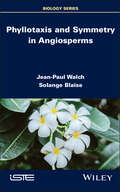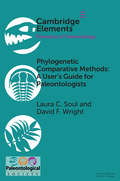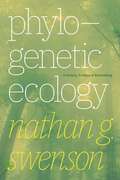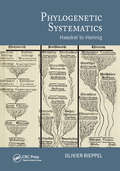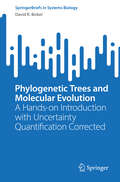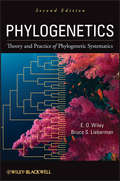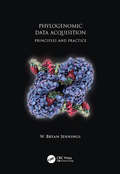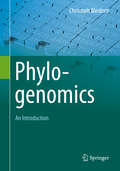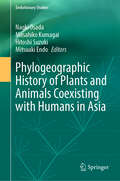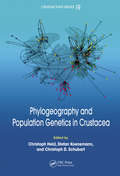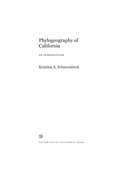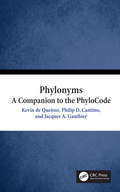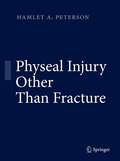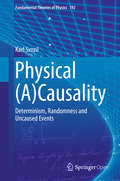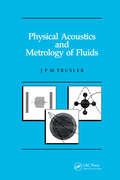- Table View
- List View
Phyllosphere Microbial Plant Pathogens: Volume 2 Management of Crop Diseases
by P. NarayanasamyThis book provides comprehensive knowledge of the methods of detection and identification of phyllosphere microbial pathogens and the management of different kinds of diseases caused by them in various crops. Interactions between pathogens and host plants result in the induction of defense responses expressed via molecular signals, from initiation of infection to systemic progression of pathogen invasion in susceptible plants and contrasting signals in resistant plants, leading to inhibition of pathogen development through activation of preinfectional and postinfectional defense responses. These are critically discussed.The author describes the intricate and complex competitive activities of the pathogens and host plants in a molecular warfare that the host plant must win to break the link in the pathogens' life cycle, allowing the development of disease management strategies based on the principles of exclusion, eradication, and immunization. Integration of strategies concerning the development of cultivars resistant to pathogens through breeding and biotechnological techniques, application of biotic and abiotic inducers of resistance to pathogens, and use of disease-free seeds and propagules that are complementary to each other along with effective cultural practices are emphasized.This book presents information gathered through an extensive literature search to help researchers and graduate students in agricultural sciences identify research gaps and successfully complete their research projects.
Phyllostomid Bats: A Unique Mammalian Radiation
by Theodore H. Fleming Liliana M. Dávalos Marco A. R. MelloWith more than two hundred species distributed from California through Texas and across most of mainland Mexico, Central and South America, and islands in the Caribbean Sea, the Phyllostomidae bat family (American leaf-nosed bats) is one of the world’s most diverse mammalian families. From an insectivorous ancestor, species living today, over about 30 million years, have evolved a hyper-diverse range of diets, from blood or small vertebrates, to consuming nectar, pollen, and fruit. Phyllostomid plant-visiting species are responsible for pollinating more than five hundred species of neotropical shrubs, trees, vines, and epiphytes—many of which are economically and ecologically important—and they also disperse the seeds of at least another five hundred plant species. Fruit-eating and seed-dispersing members of this family thus play a crucial role in the regeneration of neotropical forests, and the fruit eaters are among the most abundant mammals in these habitats. Coauthored by leading experts in the field and synthesizing the latest advances in molecular biology and ecological methods, Phyllostomid Bats is the first overview in more than forty years of the evolution of the many morphological, behavioral, physiological, and ecological adaptations in this family. Featuring abundant illustrations as well as details on the current conservation status of phyllostomid species, it is both a comprehensive reference for these ecologically vital creatures and a fascinating exploration of the evolutionary process of adaptive radiation.
Phyllotaxis Models: A Tool for Evolutionary Biologists
by Jean-Paul Walch Solange BlaiseThe equations of phyllotaxis were discovered by Douady and Couder: these describe the inhibition "force" generated by an incipient primordium, preventing the initiation of other primordia in its vicinity: the method that was lacking was to take into account the distance of primordia to the meristem apex over the course of its development. With these parameters, our model integrates both biochemical "forces" (inhibition due to auxin) and mechanical forces (contact pressure). This powerful tool allows us to revisit many important notions of plant biology. For example, we model auxin concentrations at the plant apex, as well as the development of vegetative and reproductive meristems. We also explain why the whorls of monocots are trimerous and those of plants with quincuncial perianths are pentamerous. We design a geometric method for reconstructing inflorescences from their building blocks, i.e. floral meristems. We also show that phyllotaxic spirals are only the application of a general property of symmetry, the advantages of which have been exploited by natural selection.
Phyllotaxis and Symmetry in Angiosperms (ISTE Invoiced)
by Jean-Paul Walch Solange BlaiseSymmetry and the causes of shifts in different types of symmetries in flowers follow specific patterns that are ruled by developmental and genetic factors. Using a unified system of phyllotaxic equations, we have modeled the molecular mechanisms and pressure forces that act in inflorescence and floral meristems, giving flowers their organ arrangement. In this book, we state general physical principles, whereby the symmetry of the perianth is derived from the symmetry of certain TCP gene expression. Thus, we define the interplay between the expression of CYC2-like genes and the phyllotactic mechanisms. This new evo-devo approach is applied to major groups of angiosperms with predominantly actinomorphic flowers (in which rare zygomorphy is positional) and groups with mainly bilaterally symmetrical flowers (in which zygomorphy is constitutional). It has thus allowed us to revisit the contributions of the great floral morphologists of the 20th and early 21st centuries.
Phylogenetic Comparative Methods: A User's Guide for Paleontologists (Elements of Paleontology)
by David F. Wright Laura C. SoulRecent advances in statistical approaches called Phylogenetic Comparative Methods (PCMs) have provided paleontologists with a powerful set of analytical tools for investigating evolutionary tempo and mode in fossil lineages. However, attempts to integrate PCMs with fossil data often present workers with practical challenges or unfamiliar literature. This Element presents guides to the theory behind, and the application of, PCMs with fossil taxa. Based on an empirical dataset of Paleozoic crinoids, it presents example analyses to illustrate common applications of PCMs to fossil data, including investigating patterns of correlated trait evolution and macroevolutionary models of morphological change. It then emphasizes the importance of accounting for sources of uncertainty and discusses how to evaluate model fit and adequacy. Finally, this Element discusses several promising methods for modelling heterogeneous evolutionary dynamics with fossil phylogenies. Integrating phylogeny-based approaches with the fossil record provides a rigorous, quantitative perspective to understanding key patterns in the history of life.
Phylogenetic Diversity: Applications and Challenges in Biodiversity Science
by Rosa A. Scherson Daniel P Faith“Biodiversity” refers to the variety of life. It is now agreed that there is a “biodiversity crisis”, corresponding to extinction rates of species that may be 1000 times what is thought to be “normal”. Biodiversity science has a higher profile than ever, with the new Intergovernmental Science-Policy Platform on Biodiversity and Ecosystem Services involving more than 120 countries and 1000s of scientists. At the same time, the discipline is re-evaluating its foundations – including its philosophy and even core definitions. The value of biodiversity is being debated. In this context, the tree of life (“phylogeny”) is emerging as an important way to look at biodiversity, with relevance cutting across current areas of concern – from the question of resilience within ecosystems, to conservation priorities for globally threatened species – while capturing the values of biodiversity that have been hard to quantify, including resilience and maintaining options for future generations.This increased appreciation of the importance of conserving “phylogenetic diversity”, from microbial communities in the human gut to global threatened species, has inevitably resulted in an explosion of new indices, methods, and case studies. This book recognizes and responds to the timely opportunity for synthesis and sharing experiences in practical applications. The book recognizes that the challenge of finding a synthesis, and building shared concepts and a shared toolbox, requires both an appreciation of the past and a look into the future. Thus, the book is organized as a flow from history, concepts and philosophy, through to methods and tools, and followed by selected case studies. A positive vision and plan of action emerges from these chapters, that includes coping with inevitable uncertainties, effectively communicating the importance of this “evolutionary heritage” to the public and to policy-makers, and ultimately contributing to biodiversity conservation policy from local to global scales.
Phylogenetic Ecology: A History, Critique, & Remodeling (Use R! Ser.)
by Nathan G. SwensonOver the past decade, ecologists have increasingly embraced phylogenetics, the study of evolutionary relationships among species. As a result, they have come to discover the field’s power to illuminate present ecological patterns and processes. Ecologists are now investigating whether phylogenetic diversity is a better measure of ecosystem health than more traditional metrics like species diversity, whether it can predict the future structure and function of communities and ecosystems, and whether conservationists might prioritize it when formulating conservation plans. In Phylogenetic Ecology, Nathan G. Swenson synthesizes this nascent field’s major conceptual, methodological, and empirical developments to provide students and practicing ecologists with a foundational overview. Along the way, he highlights those realms of phylogenetic ecology that will likely increase in relevance—such as the burgeoning subfield of phylogenomics—and shows how ecologists might lean on these new perspectives to inform their research programs.
Phylogenetic Inference, Selection Theory, and History of Science: Selected Papers of A. W. F. Edwards with Commentaries
by Rasmus Grønfeldt WintherA. W. F. Edwards is one of the most influential mathematical geneticists in the history of the discipline. One of the last students of R. A. Fisher, Edwards pioneered the statistical analysis of phylogeny in collaboration with L. L. Cavalli-Sforza, and helped establish Fisher's concept of likelihood as a standard of statistical and scientific inference. In this book, edited by philosopher of science Rasmus Grønfeldt Winther, Edwards's key papers are assembled alongside commentaries by leading scientists, discussing Edwards's influence on their own research and on thinking in their field overall. In an extensive interview with Winther, Edwards offers his thoughts on his contributions, their legacy, and the context in which they emerged. This book is a resource both for anyone interested in the history and philosophy of genetics, statistics, and science, and for scientists seeking to develop new algorithmic and statistical methods for understanding the genetic relationships between and among species both extant and extinct.
Phylogenetic Systematics: Haeckel to Hennig (Species And Systematics Ser.)
by Olivier RieppelPhylogenetic Systematics: Haeckel to Hennig traces the development of phylogenetic systematics against the foil of idealistic morphology through 100 years of German biology. It starts with the iconic Ernst Haeckel-the German Darwin from Jena-and the evolutionary morphology he developed. It ends with Willi Hennig, the founder of modern phylogenetic
Phylogenetic Trees and Molecular Evolution: A Hands-on Introduction with Uncertainty Quantification Corrected (SpringerBriefs in Systems Biology)
by David R. BickelThis book serves as a brief introduction to phylogenetic trees and molecular evolution for biologists and biology students. It does so by presenting the main concepts in a variety of ways: first visually, then in a history, next in a dice game, and finally in simple equations. The content is primarily designed to introduce upper-level undergraduate and graduate students of biology to phylogenetic tree reconstruction and the underlying models of molecular evolution. A unique feature also of interest to experienced researchers is the emphasis on simple ways to quantify the uncertainty in the results more fully than is possible with standard methods.
Phylogenetics of Bees
by Rustem Abuzarovich Ilyasov Hyung Wook KwonBees are flying insects of the order Hymenoptera closely related to wasps and ants. The ancestors of bees are assumed to be predatory wasps, which switched to pollen consumption. Further, bees co-evolved with flowering plants and divided into several species according to climatic conditions. Widely known bees are western bees Apis mellifera, and eastern bees Apis cerana. This book sheds light on features of evolution, phylogenesis, speciation, adaptation to environment, and taxonomy of bees. It will be of particular relevance to evolutionists, geneticists, taxonomists, ecologists, population geneticist, and breeders.
Phylogenetics: Theory and Practice of Phylogenetic Systematics
by Bruce S. Lieberman E. O. WileyThe long-awaited revision of the industry standard on phylogenetics Since the publication of the first edition of this landmark volume more than twenty-five years ago, phylogenetic systematics has taken its place as the dominant paradigm of systematic biology. It has profoundly influenced the way scientists study evolution, and has seen many theoretical and technical advances as the field has continued to grow. It goes almost without saying that the next twenty-five years of phylogenetic research will prove as fascinating as the first, with many exciting developments yet to come. This new edition of Phylogenetics captures the very essence of this rapidly evolving discipline. Written for the practicing systematist and phylogeneticist, it addresses both the philosophical and technical issues of the field, as well as surveys general practices in taxonomy. Major sections of the book deal with the nature of species and higher taxa, homology and characters, trees and tree graphs, and biogeography—the purpose being to develop biologically relevant species, character, tree, and biogeographic concepts that can be applied fruitfully to phylogenetics. The book then turns its focus to phylogenetic trees, including an in-depth guide to tree-building algorithms. Additional coverage includes: Parsimony and parsimony analysis Parametric phylogenetics including maximum likelihood and Bayesian approaches Phylogenetic classification Critiques of evolutionary taxonomy, phenetics, and transformed cladistics Specimen selection, field collecting, and curating Systematic publication and the rules of nomenclature Providing a thorough synthesis of the field, this important update to Phylogenetics is essential for students and researchers in the areas of evolutionary biology, molecular evolution, genetics and evolutionary genetics, paleontology, physical anthropology, and zoology.
Phylogenomic Data Acquisition: Principles and Practice
by W. Bryan JenningsPhylogenomics is a rapidly growing field of study concerned with using genome-wide data—usually in the form of DNA sequence loci—to infer the evolution of genes, genomes, and the Tree of Life. Accordingly, this discipline connects many areas in biology including molecular and genomic evolution, systems biology, molecular systematics, phylogeography, conservation genetics, DNA barcoding, and others. With the advent of Next Generation Sequencing in addition to advances in computer hardware and software over the past decade, researchers can now generate unparalleled phylogenomic datasets that are helping to illuminate many areas in the life sciences. This book is an introduction to the principles and practices of gathering these data. Phylogenomic Data Acquisition: Principles and Practice is intended for a broad cross-section of biologists and anyone else interested in learning how to obtain phylogenomic data using the latest methods.
Phylogenomics
by Christoph BleidornThis unique textbook provides a clear and concise overview of the key principles of the complex field of phylogenomics, with a particular focus on sequencing technologies that are crucial to studying and understanding interrelations in evolutionary genomics. It includes chapters dedicated to the analysis of nucleotide sequences using assembling and alignment methods and also discusses the main strategies for phylogenetic studies, systematic errors and their correction. This highly readable textbook is intended for graduate students and young researchers with an interest in phylogenetics and evolutionary developmental biology.
Phylogenomics: A Primer
by Rob DeSalle Jeffrey Rosenfeld Michael TesslerPhylogenomics: A Primer, Second Edition is for advanced undergraduate and graduate biology students studying molecular biology, comparative biology, evolution, genomics, and biodiversity. This book explains the essential concepts underlying the storage and manipulation of genomics level data, construction of phylogenetic trees, population genetics, natural selection, the tree of life, DNA barcoding, and metagenomics. The inclusion of problem-solving exercises in each chapter provides students with a solid grasp of the important molecular and evolutionary questions facing modern biologists as well as the tools needed to answer them.
Phylogeny and Evolution of Bacteria and Mitochondria
by Mauro Degli EspostiLife on earth began with bacteria, which now colonize every corner of the planet. As the ancestors of mitochondria, bacteria are also fundamental for our cells. Most bacteria look alike, but have very different functions. Therefore, knowing the functional profile of bacteria helps understand their impact on our life. This book provides a wealth of information on the functional evolution of bacteria in a novel and coherent way. The book is aimed towards scientists as well as those who are curious about the world of bacteria and their relationships with mitochondria, the powerhouses of our cells, and us.
Phylogeny and Evolution of the Angiosperms: Revised and Updated Edition
by Steven Manchester Douglas Soltis Pamela Soltis Peter Endress Mark W. Chase Walter Judd Lucas Majure Evgeny MavrodievAlthough they are relative latecomers on the evolutionary scene, having emerged only 135‒170 million years ago, angiosperms—or flowering plants—are the most diverse and species-rich group of seed-producing land plants, comprising more than 15,000 genera and over 350,000 species. Not only are they a model group for studying the patterns and processes of evolutionary diversification, they also play major roles in our economy, diet, and courtship rituals, producing our fruits, legumes, and grains, not to mention the flowers in our Valentine’s bouquets. They are also crucial ecologically, dominating most terrestrial and some aquatic landscapes. This fully revised edition of Phylogeny and Evolution of the Angiosperms provides an up-to-date, comprehensive overview of the evolution of and relationships among these vital plants. Incorporating molecular phylogenetics with morphological, chemical, developmental, and paleobotanical data, as well as presenting a more detailed account of early angiosperm fossils and important fossil information for each evolutionary branch of the angiosperms, the new edition integrates fossil evidence into a robust phylogenetic framework. Featuring a wealth of new color images, this highly synthetic work further reevaluates long-held evolutionary hypotheses related to flowering plants and will be an essential reference for botanists, plant systematists, and evolutionary biologists alike.
Phylogeographic History of Plants and Animals Coexisting with Humans in Asia (Evolutionary Studies)
by Hitoshi Suzuki Naoki Osada Masahiko Kumagai Mitsuaki EndoThis book offers a comprehensive understanding of the natural history of the Japanese Archipelago (Yaponesia), employing cutting-edge genomic research to provide insights into the prehistory in this region. It provides an in-depth exploration of the genetic makeup of domesticated plants and animals in the Japanese Archipelago, including their relationships with neighboring regions in Asia. The book is unique in its comprehensive approach, weaving together the latest genomic research, historical records, and linguistic analysis to provide a detailed understanding of the past. The book covers the development of Japanese society and culture from the Jomon era to the present day. It discusses the animal and plant diversity of the country, including their distribution, evolution, and interaction with human society and culture. The linguistic distributions of related terms are also explored. Using the latest genomic research, the book offers a fresh perspective on the past and present of the Japanese Archipelago, providing a comprehensive understanding of the natural and cultural history of the Japanese Archipelago. It is a valuable resource for professionals and academics in genomics, archaeology, and linguistics, as well as general readers interested in Japanese history, culture, and the environment.
Phylogeography and Population Genetics in Crustacea
by Stefan Koenemann Christoph Held Christoph D. SchubartRecently, technological progress and the rise of DNA barcoding efforts have led to a significant increase in the availability of molecular datasets on intraspecific variability. Carcinologists and other organismal biologists, who want to use molecular tools to investigate patterns on the scale of populations, face a bewildering variety of genetic m
Phylogeography of California
by Kristina A. SchierenbeckPhylogeography of California examines the evolution of a variety of taxa--ancient and recent, native and migratory--to elucidate evolutionary events both major and minor that shaped the distribution, radiation, and speciation of the biota of California. The book also interprets evolutionary history in a geological context and reviews new and emerging phylogeographic patterns. Focusing on a region that is defined by physical and political boundaries, Kristina A. Schierenbeck provides a phylogeographic survey of California's diverse flora and fauna according to their major organismal groups. Life history and ecological characteristics, which play prominent roles in the various outcomes for respective clades, are also considered throughout the work. Supporting scholars and researchers who study evolutionary diversification, the book analyzes research that helps assess one of the major challenges in phylogeographic studies: understanding changes in population structures shaped by geological and geographical processes. California is one of only twenty-five acknowledged biological hotspots worldwide, and the phylogeographic history of the state can be extrapolated to study other regions in western North America. Further consideration is given to implications for conservation, recommendations concerning the biogeographic provinces that roughly define the state of California, and predictions related to climate change.
Phylonyms: A Companion to the PhyloCode
by Philip D. Cantino Kevin De Queiroz Jacques A. GauthierPhylonyms is an implementation of PhyloCode, which is a set of principles, rules, and recommendations governing phylogenetic nomenclature. Nearly 300 clades - lineages of organisms - are defined by reference to hypotheses of phylogenetic history rather than by taxonomic ranks and types. This volume will document the Real World uses of PhyloCode and will govern and apply to the names of clades, while species names will still be governed by traditional codes. Key Features Provides clear regulations for implementing new guidelines for naming lineages of organisms incorporates expressly evolutionary and phylogenetic principles Works with existing codes of nomenclature Eliminates the reliance on rank-based classification in favor of phylogenetic relationships Related Titles: Rieppel, O. Phylogenetic Systematics: Haeckel to Hennig (ISBN 978-1-4987-5488-0) Cantino, P. D. and de Queiroz, K. International Code of Phylogenetic Nomenclature (PhyloCode) (ISBN 978-1-138-33282-9).
Physeal Injury Other Than Fracture
by Hamlet A. PetersonThis book documents all the ways a growth plate can be damaged, other than fracture. This damage can be inflicted by a wide variety of insults, most of which are uncommon occurrences. They all, however, have two similar characteristics: normal roentgenographs at the time of insult and premature complete or partial arrest noted weeks, months, or years later. Because of this delay, the arrest is often not suspected or recognised early. The resulting bone deformity and relative shortening usually go undetected until corrective surgery is needed. This book emphasises etiology, diagnosis, and treatment of these injuries.
Physical (A)Causality
by Karl SvozilThis open access book addresses the physical phenomenon of events that seem to occur spontaneously and without any known cause. These are to be contrasted with events that happen in a (pre-)determined, predictable, lawful, and causal way. All our knowledge is based on self-reflexive theorizing, as well as on operational means of empirical perception. Some of the questions that arise are the following: are these limitations reflected by our models? Under what circumstances does chance kick in? Is chance in physics merely epistemic? In other words, do we simply not know enough, or use too crude levels of description for our predictions? Or are certain events "truly", that is, irreducibly, random? The book tries to answer some of these questions by introducing intrinsic, embedded observers and provable unknowns; that is, observables and procedures which are certified (relative to the assumptions) to be unknowable or undoable. A (somewhat iconoclastic) review of quantum mechanics is presented which is inspired by quantum logic. Postulated quantum (un-)knowables are reviewed. More exotic unknowns originate in the assumption of classical continua, and in finite automata and generalized urn models, which mimic complementarity and yet maintain value definiteness. Traditional conceptions of free will, miracles and dualistic interfaces are based on gaps in an otherwise deterministic universe.
Physical Acoustics and Metrology of Fluids
by Martin TruslerThe interaction of sound waves with the medium through which they pass can be used to investigate the thermophysical properties of that medium. With the advent of modern instrumentation, it is now possible to determine the speed and absorption of sound with extremely high precision and, through the dependence of those quantities on variables like temperature, pressure, and frequency to gain a sensitive measure of one or more properties of fluid. This has led to renewed interest in such measurements and in the extraction of thermophysical properties of gases and liquids there from. Physical Acoustics and Metrology of Fluids describes both how to design experiments to achieve the highest possible accuracy and how to relate the quantities measured in those experiments to the thermophysical properties of the medium. A thorough theoretical examination of the alternative experimental methods available is designed to guide the experimentalist toward better and more accurate methods. This theoretical analysis is enhanced and complemented by an in-depth discussion of practical experimental techniques and the problems inherent within them. Bringing together the fields of thermodynamics, kinetic theory, fluid mechanics, and theoretical acoustics, plus a wealth of information about practical instruments, this book represents an essential reference on the design and execution of valuable experiments in fluid metrology and physical acoustics.
Physical Agents in Rehabilitation: From Research To Practice
by Michelle H. CameronPresenting a variety of treatment choices supported by the latest clinical research, Physical Agents in Rehabilitation: From Research to Practice, 4th Edition is your guide to the safe, most effective use of physical agents in your rehabilitation practice. Coverage in this new edition includes the most up-to-date information on thermal agents, ultrasound, electrical currents, hydrotherapy, traction, compression, lasers, and electromagnetic radiation. Straightforward explanations make it easy to integrate physical agents into your patients' overall rehabilitation plans.
